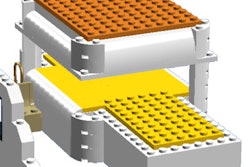
In the effort to reduce noise in MRI scans, a variety of new technologies have been introduced. Researchers from New Zealand assessed one of these technologies in a study published in the February American Journal of Roentgenology and found it may be suited for T1-weighted MRI but not MR angiography (MRA).
In a comparison of T1-weighted imaging, the conventional MRI scanning approach was preferred over a technology called Silent Scan (GE Healthcare) for image quality and lesion conspicuity, but the same trio of neuroradiologists expressed slightly greater diagnostic confidence with Silent Scan. In the MRA comparison, however, conventional MRI scanning was tops in all three categories.
"T1-weighted Silent Scans were largely equivalent to conventional scans," wrote lead author Dr. Samantha Holdsworth from the University of Auckland and colleagues. "We did not come to the same conclusion regarding the Silent MRA method, which had multiple suboptimal features that limited image interpretation, such that significant improvements are required before it can be recommended in a clinical population."
Quiet, please
As MRI continues its ascent to a wider array of clinical applications, more patients are expected to endure sometimes long, noisy, and uncomfortable scans. It's estimated that noise levels in some MRI scanners can reach 130 decibels (dB). By comparison, a power lawn mower, motorcycle, or jackhammer creates 100 dB of noise, according to a Purdue University study.
Needless to say, that kind of volume can cause additional stress for patients who may already be dealing with scan-related claustrophobia, the authors noted. As a result, the need to develop a quieter MRI scan has been in the offing.
GE introduced its Silent Scan technology in 2012. It is designed to lower acoustic noise levels to approximately 50 dB to 70 dB by reducing the slew rate, compared with conventional imaging sequences. The ultrafast imaging technique also uses a 3D gradient-echo sequence with very short time-to-echo (TE) and rapid low-flip-angle radiofrequency pulses to acquire free induction decays, instead of echoes. Because the magnetic field gradient remains constant while its direction is rotated by relatively small increments, the result is a quieter study, the authors explained (AJR, February 2018, Vol. 210:2, pp. 404-409).
"Because it acquires free induction decays rather than echoes (resulting in a shorter TE), Silent Scan is less sensitive to motion, flow, and diffusion," they wrote. "However, because the readout time is longer, Silent MRI is more prone to blurring. In addition, there have been some early reports that the Silent protocol compromises image quality, with one report noting poorer signal-to-noise ratio for the Silent Scans compared with conventional scans."
And while the reduction in acoustic noise with Silent Scan is "significant," the authors added that "it is important to assess image quality and diagnostic accuracy for these sequences in reference to their conventional counterparts."
Head-to-head comparison
The researchers designed a study that included 40 patients (median age, 60 years; range, 23-91 years) with suspected brain metastases who underwent contrast-enhanced T1-weighted conventional imaging followed by Silent Scan T1-weighted imaging between March and July 2015. In addition, 51 patients (median age, 60 years; range, 16-94 years) with suspected vascular lesions or cerebral ischemia underwent unenhanced intracranial MR angiography using both imaging techniques.
All MRI exams were performed on a 3-tesla scanner (MR750, GE) with an eight-channel receive-only head coil. Scan times lasted three minutes and 25 seconds for both conventional and Silent Scan imaging.
Using conventional MR images as the reference standard, three neuroradiologists, each with at least seven years of experience, blindly and randomly evaluated the results. The trio rated the diagnostic image quality of the Silent Scan MR images on a five-point scale, with 1 as nondiagnostic, 3 as borderline, and 5 as excellent.
In the analysis of the T1-weighted scans, conventional MRI achieved higher average scores than Silent Scan for image quality and lesion conspicuity. The exception was diagnostic confidence, which was essentially the same with no statistically significant difference.
Interestingly, the Silent Scans were deemed to be better than or equal to the conventional scans in 62% of the T1-weighted cases. In addition, 95% of the Silent Scan images were rated as having standard diagnostic quality or better for diagnostic confidence.
| Neuroradiologist ratings of Silent Scan image quality for T1 MRI | |||
| Conventional MRI | Silent Scan | p-value | |
| Image quality: blurring | 4.0 ± 0.5 | 3.5 ± 0.3 | < 0.001* |
| Image quality: signal-to-noise ratio | 3.9 ± 0.5 | 3.7 ± 0.3 | < 0.001* |
| Lesion conspicuity | 3.9 ± 0.6 | 3.8 ± 0.3 | < 0.05 |
| Diagnostic confidence | 3.9 ± 0.6 | 4.0 ± 0.2 | Not significant |
Among the 51 patients who underwent an MRA scan, conventional MRI outpaced the Silent MRA, with all categories showing a statistically significant difference. Only 48% of Silent MRI scans were considered to have diagnostic quality, compared with 90% of conventional MRA scans.
| Neuroradiologist ratings of Silent Scan image quality for MRA | |||
| Conventional MRI | Silent Scan | p-value | |
| Image quality: blurring | 4.0 ± 0.2 | 3.2 ± 0.6 | < 0.001 |
| Image quality: signal-to-noise ratio | 4.0 ± 0.4 | 3.5 ± 0.7 | < 0.001 |
| Lesion conspicuity | 4.0 ± 0.3 | 3.4 ± 0.7 | < 0.001 |
| Diagnostic confidence | 3.9 ± 0.4 | 3.3 ± 0.7 | < 0.001 |
Room for improvement
While the T1-weighted Silent Scans were largely equivalent to conventional scans, minor alterations in scan parameters and slightly increased scan duration could make Silent Scan imaging a "reasonable alternative to conventional scans," the authors concluded.
On the other hand, the Silent Scan MRA method had "multiple suboptimal features that limited image interpretation, such that significant improvements are required before it can be recommended in a clinical population," Holdsworth and colleagues wrote.
The authors cited several limitations of the study, including an inability to match conventional and Silent Scan MRI on factors such as scan duration, spatial resolution, and brain coverage. The use of other scan parameters could improve the quality of the Silent images, they wrote.



















